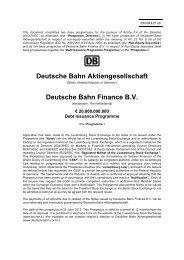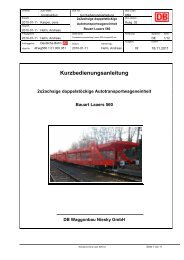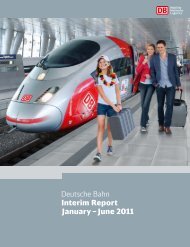PDF Download - Deutsche Bahn AG
PDF Download - Deutsche Bahn AG
PDF Download - Deutsche Bahn AG
Create successful ePaper yourself
Turn your PDF publications into a flip-book with our unique Google optimized e-Paper software.
|<br />
mAN<strong>AG</strong>EmENT rEPOrT<br />
BUSineSS environMent<br />
Development of GDP reflects the<br />
economic and financial crisis<br />
Change in gross domestic product (GDP)<br />
[%]<br />
2010 2009<br />
World 1) + 4.0 –2.3<br />
USA +2.9 –2.6<br />
China + 10.3 + 9.2<br />
Japan + 4.0 – 6.3<br />
Eurozone + 1.7 – 4.1<br />
Germany + 3.6 – 4.7<br />
1) Total selected industrial and emerging countries.<br />
Data for 2009/2010 is based on information available on February 22, 2011.<br />
Source: Consensus Forecasts, FERI, Federal Statistical Office, Germany.<br />
The global economy recovered sharply in 2010 posting a 4 % rate<br />
of growth. However, the pace slackened during the year under<br />
review. Global trade returned to its pre-crisis level as it expanded<br />
by 13.5 %. Economic performance noted in the emerging Asian<br />
and Latin-American markets posted substantially higher growth<br />
rates than the industrialized nations and were significantly higher<br />
than their pre-crisis levels. Performance seen in rapidly growing<br />
economies like China and India were key forces driving the<br />
expansion of the global economy. The industrialized nations<br />
were less dynamic as their recovery was more moderate. Although<br />
their economic performance was significantly higher than in the<br />
depths of the financial crisis, in most cases they had not yet<br />
returned to their pre-crisis levels. The pace of economic growth<br />
slowed towards the middle of 2010 due to the expiration of<br />
economic stimulus programs and necessary measures taken by<br />
governments to consolidate their budgets. The unchanged tense<br />
situation in the financial and real estate sectors, rising levels of<br />
government debt, and, in some cases, high unemployment<br />
dampened economic growth in many industrialized countries.<br />
The pace of economic growth in the USA slowed notably<br />
after the first half of the year 2010 due to the expiration of the<br />
government’s economic stimulus program and inventory buildup.<br />
The gross domestic product (GDP) of the USA rose by 3 %, mainly<br />
as a result of increased consumer spending that represents<br />
about 70 % of total economic output in the USA. The situation in<br />
the labor market remained tense as the unemployment rate was<br />
stuck at a historically high level due to sluggish job growth.<br />
Capital expenditures, and especially spending for plant and<br />
equipment, expanded strongly due to the effects of pent-up<br />
demand and more attractive refinancing conditions offered to<br />
companies. The foreign trade sector did not generate much<br />
good news as imports grew somewhat larger than exports.<br />
Asia retained its status as the fastest-growing region. A<br />
more restrictive lending policy was imposed in China in the<br />
second half of the year. Together with higher interest rates and<br />
the cautious appreciation of the exchange rate in conjunction<br />
with the expiry of economic stimulus programs, this move led<br />
to the desired cooling-off of the Chinese economy. Exports<br />
contracted during the course of the year due to weaker demand<br />
in the USA. Despite the slower pace of growth, the Chinese GDP<br />
remained at a high level as it grew by 10.3 %. Therefore China<br />
replaced Japan as the second-largest economy in the world.<br />
The recovery in Japan weakened in the second half of 2010<br />
as economic growth slowed due to the higher yen, which in turn<br />
stifled exports. Domestic demand contracted due to expiring<br />
economic stimulus programs. Additionally higher unemployment<br />
dampened consumer spending. Nevertheless, GDP exceeded<br />
the previous year’s level by 4 %.<br />
GDP rose by 1.7 % in the Eurozone. Growth was primarily<br />
driven by the strong development of the German economy. The<br />
recovery of Europe’s economy was primarily burdened by the<br />
end of economic stimulus programs and government spending<br />
cuts taken to consolidate their budgets. The low level of interest<br />
rates favorably influenced consumer spending and capital<br />
expenditures for plant and equipment. The French economy<br />
recovered from the recession at a steady pace that, however,<br />
was only average compared to the rebound seen in the other<br />
Eurozone countries. Consumer spending expanded and posted<br />
a positive contribution to growth although it was held back<br />
by high unemployment and weak development of disposable<br />
income. Although the level of gross capital expenditures recovered<br />
moderately, it stayed in the year under review below the<br />
2009 level. Exports mirrored the recovery of the global economy<br />
and expanded substantially. Imports also rose significantly. A<br />
clearly restrictive fiscal policy burdened economic recovery in<br />
Great Britain along with the darkening situation in the foreign<br />
trade sector. Despite the very moderate increase in real incomes,<br />
and a barely improved situation in the labor market, private<br />
spending rose as consumers brought forward purchases ahead<br />
of the planned increase in the value-added tax rate starting at<br />
the beginning of 2011.<br />
7

















